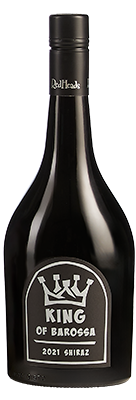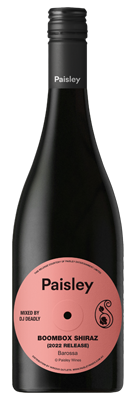Filter by
- This Gold-medal new vintage exclusive, from a big Barossa name, also won a Double Gold on debut.$28.00 RRPfrom $17.99 when you mix 12+
- A big, hearty Barossa Shiraz – with a great back story and a Gold-medal history!$26.00 RRPfrom $17.99 when you mix 12+
- Rich and Gold-winning Barossa Shiraz and the ever-impressive Patronus label.$28.00 RRPfrom $15.99 when you mix 12+
- A very pleasing Barossa Valley Shiraz that punches well above its price point.$26.00 RRPfrom $15.99 when you mix 12+
- "A thoroughly exquisite example of an old vine Barossa Shiraz" (Ray Jordan) with 95-97pt scores.$200.00 RRPfrom $185.99 when you mix 12+
- New vintage of this Barossa exclusive that's scooped Double Gold in its first two vintages!$42.00 RRPfrom $25.99 when you mix 12+
- Multi Gold-winning Barossa Shiraz from always impressive Elena Brooks.$40.00 RRPfrom $29.99 when you mix 12+
- Astonishingly pure, concentrated, 4 Gold and Platinum-winning Barossa Shiraz$40.00 RRP$28.99 when you mix 12+
- Brilliantly pink single-vineyard Shiraz Rosé grown by Barossa local Darren Heidenreich$25.00 RRPfrom $14.99 when you mix 12+
- 94pt Shiraz Shiraz Shiraz – from three distinct Marananga (Barossa) vineyards.$25.00 RRPfrom $21.99 when you mix 12+
- Second vintage of this king-sized Barossa Shiraz – and it’s outdone its Gold-medal debut vintage!$45.00 RRPfrom $27.99 when you mix 12+
- Dark and peppery Limited Release Barossa Shiraz with a lick of vanillin oak.$26.00 RRPfrom $20.99 when you mix 12+
- 94pt Shiraz Shiraz Shiraz from three distinct Marananga (Barossa) vineyards. Wow, wow and wow!$25.00 RRPfrom $21.99 when you mix 12+
- 93pt Barossa Valley Shiraz with "gobs of ripe blackberry... Plenty of Value here. 92pts" (Halliday)$25.00 RRPfrom $21.99 when you mix 12+
- "Splendidly fruited and fragrant" (Wine Orbit) 92pt Barossa Shiraz$28.00 RRPfrom $23.99 when you mix 12+
- Exclusive 95pt Shiraz from Irvine – "this is terrif!c" (Wine Orbit)$44.00 RRPfrom $24.99 when you mix 12+
- A "lovely contemporary Barossa Reserve Shiraz" (Halliday) with three Golds and 2 x 95pt scores.$50.00 RRPfrom $45.99 when you mix 12+
- Delicious 94pt Barossa Valley Shiraz. “Another cracker from the excellent 2021 vintage" (Halliday).$35.00 RRPfrom $35.00 when you mix 12+
- New vintage of the flagship, barrel-aged Shiraz from the pioneering RedHeads in the Barossa Valley.$50.00 RRPfrom $50.00 when you mix 12+
- Top vintage Barossa Shiraz with two Golds and a raft of high scores up to 96pts.$150.00 RRPfrom $145.99 when you mix 12+
- Triumphant Barossa Valley Shiraz with Gold and two 96pt scores!$180.00 RRPfrom $174.99 when you mix 12+
- 96pt Barossa. “A magnificent Shiraz" (Wine Orbit) with "... a long, velvet-like finish" (Halliday).$95.00 RRPfrom $89.99 when you mix 12+
- Delicious new vintage of the fine flagship, barrel-aged Shiraz from RedHeads in the Barossa Valley.$50.00 RRPfrom $50.00 when you mix 12+
- Magnificent Single Vineyard Shiraz from Elena Brooks, with 7 Golds, 95,96 & 97pt scores!$120.00 RRPfrom $110.00 when you mix 12+
Wine FAQs
What is Barossa Valley wine?
Barossa Valley wine comes from one of Australia’s oldest and most prestigious wine regions, the Barossa Valley, located in the heart of South Australia.
The region is best known for its bold and full-bodied Shiraz (known as Syrah elsewhere in the world). Barossa Shiraz is renowned for its rich, intense flavours, often with notes of dark fruit, chocolate and spice and its ability to age well.
In addition to Shiraz, a wide variety of popular, international varieties are grown here, made into unapologetically bold and exciting wines that taste distinctly Aussie. These include Grenache, Mourvèdre and Cabernet Sauvignon for red wines, and Riesling, Sémillon and Chardonnay for white wines.
Despite its long history and commitment to tradition, it’s also a dynamic and evolving region where winemakers are always looking to create something new and exciting for wine lovers to discover.
Where is Barossa Valley?
Situated approximately 60 kilometres northeast of Adelaide in South Australia, Barossa Valley is one of Australia’s oldest and most respected wine regions.
The valley, formed by the North Para River, is surrounded by rolling hills and covers towns such as Nuriootpa, Tanunda, Angaston and Lyndoch. The Barossa Valley shares the Barossa region with the Eden Valley wine region – together, they form the Barossa Zone.
Its Mediterranean climate, characterised by cool, rainy winters and hot, dry summers, benefits from the mitigating effects of the valley’s altitude and cool evening breezes. The evening chill helps the grapes ripen fully and consistently, allowing them to keep their balanced acidity. The end result? Grapes that create full-bodied, robust wines that have earned the region an international reputation.
What is Barossa’s winemaking history?
The roots of Barossa Valley’s winemaking history date back to the mid-19th century, when German settlers planted the first vineyards. They brought with them a wealth of viticultural knowledge and traditional winemaking techniques, laying the foundation for the consistently high-quality wines the region produces today.
The region is famous as the home to the world’s oldest, continuously producing Shiraz, Grenache, Mataro, Cabernet Sauvignon and Sémillon vines.
What grapes are grown in Barossa?
The Barossa Valley is renowned for its creative and innovative attitude to wine production, with a variety of grapes grown in the area. Some of the key varieties include:
- Shiraz – The star of the Barossa Valley, Shiraz is known for its bold, full-bodied wines with punchy flavours of ripe black fruit, chocolate and tobacco.
- Cabernet Sauvignon – Known for its deep colour and full-bodied flavour, Cabernet Sauvignon from Barossa often delivers notes of blackcurrant, menthol and violet.
- Chardonnay – A versatile grape, Chardonnay in Barossa varies from light and crisp to smooth and buttery, depending on the winemaking process.
- Grenache – Grenache in Barossa is typically used in Rhône-style GSM blends, producing wines with berry and spice flavours. Grenache is resilient to heat, which makes it well-suited to Barossa’s climate.
- Mataro (Mourvèdre) – Mostly used in blends, Mataro adds complexity and provides good colour and tannin structure. These wines often exhibit earthy and savoury notes.
- Merlot – Merlot grapes grow well in the Barossa Valley, producing wines that are medium to full-bodied with red fruit characteristics.
- Riesling – Riesling here often displays citrus flavours with distinct mineral qualities and high acidity. It’s primarily grown in the cooler, nearby Eden Valley region.
- Sémillon – An early-ripening grape, Sémillon in Barossa is often made into both dry and sweet wines. It typically delivers a range of flavours from lime to apricot and has excellent ageing potential.
What is Barossa Valley’s best-known red wine?
Barossa is famous for its bold, hearty red wines, especially Shiraz and Cabernet Sauvignon.
Barossa Valley Shiraz is a flavour-packed powerhouse, filled with rich, black fruit tastes, hints of dark chocolate, vanilla and the pop of black pepper. Thanks to the warm South Australian sun, the grapes get super ripe, leading to fruity, complicated and strong wines with a bit of a punch from the alcohol.
Barossa Cabernet Sauvignon is just as full-bodied as Barossa Valley Shiraz, but it’s got a deeper, warmer style, full of flavours such as blackcurrant, black cherry, baking spices and cedar. These wines have bold tannins and loads of depth.
Then there’s Grenache, another popular red wine from the region. It’s often used in blends to add body and fruity character. One big player in the Barossa wine scene is the GSM blend, which stands for Grenache, Shiraz and Mourvèdre (referred to as Mataro in Australia). These blends are versatile, rich and simply delicious.
All these wines are known for their intensity and richness, reflecting the warm, sunny climate of the Barossa Valley.
What is Barossa Valley’s best-known white wine?
Barossa’s top white wines are Chardonnay and Sémillion.
Barossa Valley Chardonnay differs slightly from the lighter styles you might find in France or California. It’s full-bodied and indulgent. Imagine a wine bursting with flavours such as yellow apple, pear, lemon and pineapple – that’s what all those sunny days do to the grapes in Barossa. Many of these Chardonnays spend some time in oak barrels, which add a creamy texture and tasty hints of butter, vanilla, baking spices and toasted brioche.
Barossa Valley Sémillon is typically full-bodied with moderate acidity and flavours of citrus and tropical fruits. These wines often have a good ageing potential and can develop complex, honey and toasty characters over time.
What foods pair well with Barossa Valley wine?
A hearty Barossa Valley red is the perfect match for a classic Aussie barbecue.
If you’re pouring a rich Shiraz, try it with lamb kebabs, smoked sausage, tender pork shoulder or grilled marinated veggies. With a Barossa Valley Cabernet Sauvignon, known for its intense dark fruit flavours and firm tannins, go for juicy beef burgers, smoked ribs or medium-rare ribeye steaks. Not a barbecue fan? No worries, these wines also go great with stuffed mushrooms or bell peppers, or a rich tomato-based pasta dish.
If you prefer white wine, a full-bodied, oaked Barossa Chardonnay pairs beautifully with roast chicken or turkey, creamy salmon dishes, risotto, pasta with creamy sauces, and delicate white fish. If you’ve chosen a rarer, unoaked style, it will work wonderfully with lighter dishes such as shellfish, chicken dishes and fresh salads topped with Gouda or mild blue cheese. The honeyed, nutty character of aged Barossa Sémillon beautifully complements grilled fish or shellfish, balancing the dish’s richness.
Enjoy experimenting with these pairings!
How to serve Barossa Valley wine
Barossa Valley wines should be served at the right temperature to truly express their character. Red wines like Shiraz, Cabernet Sauvignon and Mataro should be served slightly cooler than room temperature, around 16-18°C. White wines like Chardonnay and Sémillon should be served chilled – between 10-13°C.
Use larger, bowl-shaped glasses for red wines to enhance their aromas, while smaller, narrower white wine glasses work best for white wines. This preserves their delicate aromas and prevents them from becoming too warm.



























